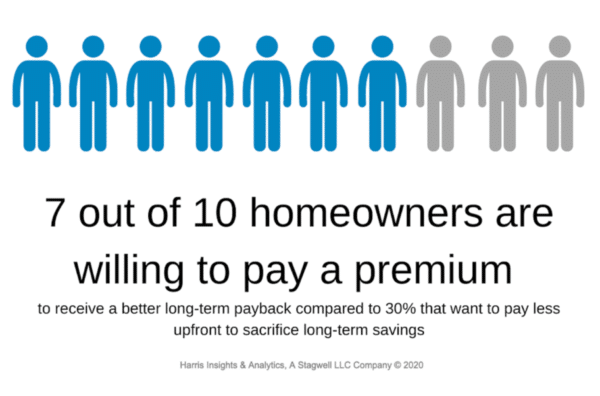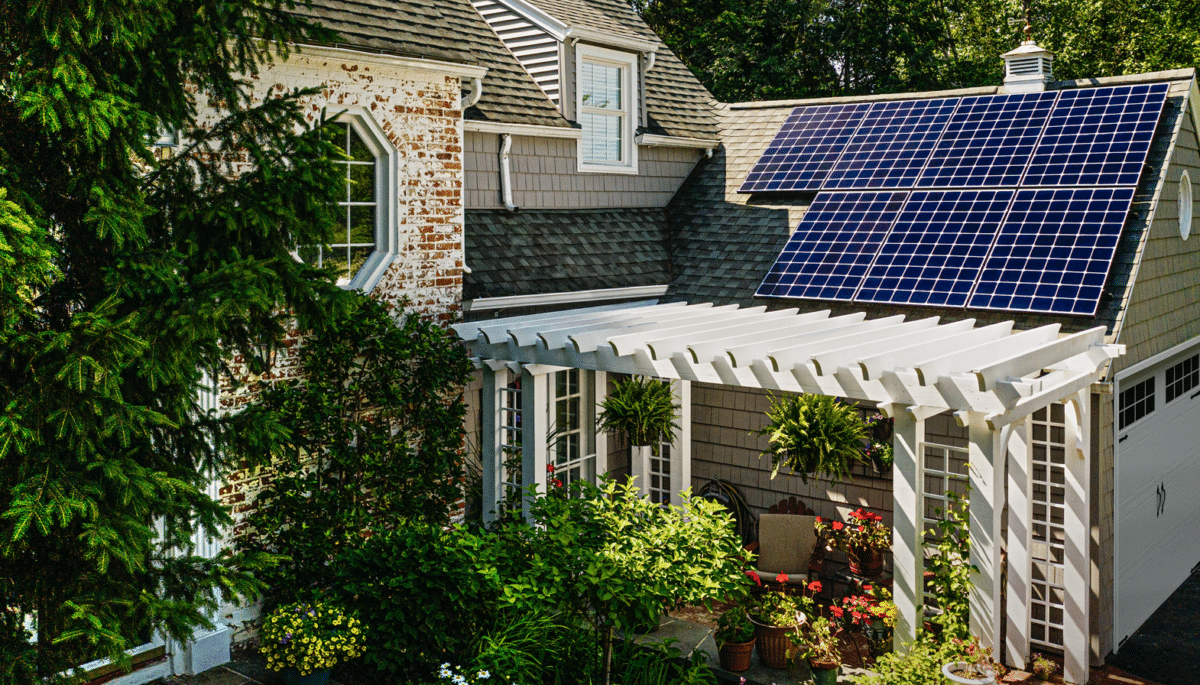The independent, third-party consumer research firm Harris Poll surveyed more than 2,000 homeowners who were either actively considering going solar or had gone solar within the last two years. LG Electronics commissioned the study to help the industry understand what homeowners see these days as important to get from the buying experience – both from the installers and from panel manufacturers. They also surveyed installers to see how well their views on what homeowners want matched what homeowners actually want.
The survey results provide important consumer insights about investing in solar, brands and warranties that installers should carefully consider.
Homeowners see going solar as a long-term investment, not a short-term cost
Selling solar is as much of a technology sale as it is a financial one. Consumers understand that going solar represents an investment of 20 to 25 years. By phrasing proposal and sales terminology as “an upfront investment” versus “costs,” consumers may be less inclined to immediately negotiate the price down.
Although installation cost matters, consumers told Harris they care more about how much of their energy bill will be offset than about installation expense. In fact, 70% of consumers are willing to pay a premium of several thousand dollars to receive a better long-term payback – versus a 30% minority who want to pay less upfront to sacrifice long-term savings. Three quarters said they are willing to pay a premium to buy technology that they perceive to be better quality.

Panel brand matters and can help build an installer’s brand
Now that in-person contact with homeowners is limited, finding different ways to instill confidence in going solar is critical. Findings from the poll say: “Known brands have the presence to make customers feel secure – these brands have something to lose, which makes them less likely to put out a sub-par product. Homeowners feel much more confident that a known brand will still be in business in the future and will be able to uphold guarantees.”
To test this theory, Harris used “Discreet Choice Modeling” to determine if consumers will pay around 15% more for a proposal that was branded with LG, compared to a proposal that was identical in all technical attributes but didn’t indicate it had LG panels. That same exercise provided LG a roughly 10% premium over a stated “solar brand” with the same attributes. If you are selling panels made by a company that is well known to consumers, the Harris data says you can command a 10% to 15% higher premium, which translates to direct margin to the installer because consumers will have more confidence in their solar investment.
It’s the price homeowners have put on greater confidence in their solar investment.
As one homeowner told Harris in a focus group session: “….it’s going to be a big investment, something we’re investing in our future. So yeah, that kind of thing is important. I don’t care so much about a warranty on a cheap piece of electronics at Walmart. If it’s something I’m going to be investing in for 25 years, then yeah.”
Regardless of which brand of panels you prefer to sell, it’s important to explore homeowner perception of solar brands to see if your customer is in the 70% of those who want to pay more for peace of mind. Learning about their choices of cars, electronics or home appliances can help give you some insights into their buying psychology.
Consumers willing to pay more for better warranties
When Harris asked consumers who had already purchased solar to rank factors influencing their decision, warranty structure was far below “quality,” “efficiency,” “installer recommendation” and “price.” However, this seemed contradictory to 97% of homeowners saying that “wanting to know the company would be around in 20 years” was “very important” to them. Here we have pre-solar customers saying warranty is very important, but post-solar consumers finding it didn’t matter as much.
Could it be that after consumers realize most solar products are generally highly reliable, the warranty’s importance diminishes? To test this, Harris looked at different warranty structures – some that included a labor reimbursement versus ones without. They also tested those covering the degradation rates without providing the context of what the value of the different levels of power-competing panels generated.
The clear winner in the eyes of homeowners? A low-degradation, “Triple 25” style warranty held the highest value for consumers. The warranty structure was almost twice as valuable as a “standard” 10-year product, 25-year performance at .7 percent degradation rate warranty. Consumers indicated they’d pay as much as 25% more for a warranty covering product, labor and performance. This is in contrast with how installers rate warranty structures – they say they think it’s relatively low in importance for consumers.
The bottom line is that actively selling the component warranty structure and its associated value holds significant importance in the eyes of customers. If you’re a company that installs a product with a strong warranty, this insight tells us it’s one of the greatest ways to create differentiation and hold a price premium – but only if the installer actively sells the warranty’s value to the customer.
Final takeaways
Consumers can be intimidated by the process of going solar. They face competing quotes from companies all pitching different products, various financing options, and differing technology types that all promise recouping their investment in five to seven years.
The way the industry has been selling solar had some weaknesses before the pandemic:
- Installers sold on price, not long-term value.
- Installers under-explained warranties and system performance and their importance.
- Many installers shied away from using their manufacturers’ brand to strengthen their own.
In this socially-distant selling environment, those weaknesses can’t be overcome with effective, in-person conversations that are now happening by phone or videoconference.
The good news is that consumers have given us new insights into their preferences. In Harris research, installers showed they know most of what their customers want, but it’s important to hone in on the gaps between installer perception and homeowner reality. To succeed in the new environment, the conversation must switch from a “cost” to an “investment” and installers should leverage brand equity for those manufacturers that can offer it, while ensuring proposals are accurately capturing the full value of the lifetime performance of the system.
Customers don’t want to buy the cheapest system when making a $20,000 investment. They want the best one. These and other insights gleaned from Harris’ data should hopefully help installers meet homeowners where they are to efficiently close more deals.
***
Brian Lynch leads solar business development for LG Business Solutions USA, the B2B division of LG Electronics USA.
The views and opinions expressed in this article are the author’s own, and do not necessarily reflect those held by pv magazine.
This content is protected by copyright and may not be reused. If you want to cooperate with us and would like to reuse some of our content, please contact: editors@pv-magazine.com.








Hello Brian,
Interesting article. We put our Solar Array on-line as we were moving into our newly built home going on two years ago now. Following are some of my observations. Our intent was to have an all solar powered home. By this I mean that everything is powered by solar generated electric. We have two exceptions, our cook stove is gas as we simply like gas cooking much better than electric, and we have a wood burning fireplace because I love a good fireplace. As we own a farm, our wood is free. We do have an high efficiency Heat Pump to handle our regular HVAC needs
Initial estimates, from two installers, were that we would need a 9.15KWh system. We choose a 9.15KWh ground mount 30 panel system with a SolarEdge inverter. As home building progressed, we decided against the originally planned Geo-thermal HVAC system as the tax credit had gone away but system pricing had not gone down. My thought was if a heat pump required more electricity, we could install ten more panels for less than the extra cost of the Geothermal and, still get the federal tax credit.
At the end of the first winter season, it was obvious that the 10 extra panels would be a good idea. We got estimates on 10 more panels and a battery back-up system. After a few months of research and winter approaching, I decided that battery systems were not quite ready for prime time and nixed that portion for the time. We added ten more panels and a second SolarEdge inverter. After our second winter season and well into summer it is obvious that the 40 panel system will serve our needs.
What have we learned? First, do not skimp on the inverter! The inverter will probably be the highest single cost item of your entire system. Get an inverter that can easily handle the panels you install now and can handle more and/or higher wattage panels in the future. Don’t buy the argument on the advantages of “clipping”. We initially installed a 7600KWh inverter on our 9.15KWh system believing we were taking advantage of clipping. When it was time to install 10 more panels, we had no room to grow. So, we added the second SolarEdge inverter. This time, a 6000KWh inverter. Now we have some room to grow when the day comes and I want to install some extra panels to power our future electric vehicle.
There is something else I have learned after the 10 more panels and a second inverter. We arranged the panels so that the inverters shared the load more equally. Mathematically, our solar production should have gone up 42 percent. So far, our solar production is up 50 percent. It appears that we may have been “clipped” in a way that was not so beneficial to us!
Some additional thoughts on inverters and batteries. As you are well aware, the technology is progressing rapidly. Even a year ago, panel output and efficiencies were less than they are today. Batteries and Battery Management Systems are evolving and progressing as well. A year ago it was hard to get a battery system to go with an inverter system of your choice, their software did not necessarily play well together. The big reason I backed off.
We are well satisfied with our system and do have room for expansion. Now, if we were starting this project from scratch today, what would I do? I would consider, (liberally), all of my immediate solar needs and potential future needs, including that electric vehicle(s). Install an inverter that will handle those current and anticipated future needs. Get an inverter that will accept a battery back-up system as well as generator back-up. Now, you have a system that can handle your growing needs. You can move forward without backing up and replacing!
Good Luck
Customers are willing to pay more for higher end products? Do tell!
Tesla is in the process of blowing everyone out of the water with $2/W pricing and online ordering.
These bloated sales orgs can make up all the nonsense they like to make themselves appear vital to the process. In reality, they’re the only thing holding back US residential from scaling.
I have some trees shading my garage with a large south facing roof. I can’t find an installer that will include cutting them back. These guys need to learn about one stop shopping.
I agree about the importance of the warranty. If you’re buying a product to save you money in the long run, you better believe it should last for it’s life-span.